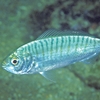General Description
Body robust, tapering to a short compressed tail base, with short-based dorsal and anal fins; head very broad, flattened, with a very short wide snout; pelvic fins united to form a large sucking disc on the underside, edged posteriorly with a fleshy fringe; mouth small, with a strong spine embedded in skin on either side of head. Usually a mottled brown greenish, with pale greenish spots on the back and darker spots forming bands on the back in juveniles. To 8 cm.
Biology
Common, but rarely seen on intertidal and subtidal rocky reefs, weedy areas and under jetties.
Habitat
Intertidal and subtidal rocky reefs, to depths of about 12 m.
Reefs
Coastal shores
Distribution guide
South-eastern Australia.
Species Group
Fishes › Clingfishes and shore-eels
Depth
Shore (0-1 m)
Shallow (1-30 m)
Water Column
Max Size
8 cm
Commercial Species
No
Global Dispersal
Native to Australia
Identify
Conservation Status
- DSE Advisory List : Not listed
- EPBC Act 1999 : Not listed
- IUCN Red List : Not listed





